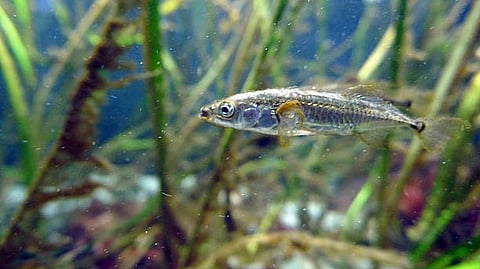

Lugging around a tapeworm that’s one third your body weight can be a real drag. So threespine stickleback fish evolved resistance to tapeworms—but resistance has costs of its own, a team of researchers show in Science on 8 September.
When threespine stickleback fish left marine waters to colonize northern freshwater lakes around 12,000 years ago, they encountered freshwater tapeworms. The tapeworms invaded their abdomens and grew, reaching enormous sizes of a quarter to a third of the host fish’s body weight. It would be like an average sized human carrying around a 50lb tapeworm. Some populations of sticklebacks quickly evolved a defense: upon encountering a tapeworm, their immune system forms scar tissue around it, stopping its growth. But other populations of stickleback tolerate the worms instead, scarring only a little or not at all.
Groups of sticklebacks that scar against tapeworms and those that don’t can live quite close to each other, in lakes just miles apart. Until now, no one has understood why some stickleback populations evolved one way, and some another.
“We see this in Alaska, in British Columbia. Colleagues have seen it in Scandinavia,” says UConn biologist Dan Bolnick.
“The neat thing about coevolution between tapeworms and fish is that it’s a remarkably dynamic process, and there are different outcomes to this evolutionary battle in every place that we look,” says Jesse Weber, a biologist at the University of Wisconsin-Madison.
Bolnick, Weber, and Natalie Steinel, a biologist and associate director of the Center for Pathogen Research & Training at the University of Masssachusetts-Lowell, worked together to answer the question of stickleback parasite resistance. Along the way, they showed that resistance to parasites isn’t always a good thing.
They studied sticklebacks from nearby lakes Roberts and Gosling on Vancouver Island in British Columbia. Both lakes have tapeworms, and both have sticklebacks. The two populations of stickleback fish are extremely similar. The major difference is that Roberts fish scar aggressively to prevent tapeworms from growing, and Gosling fish don’t. They only other obvious difference is that females from Roberts reproduce much less successfully than females from Gosling, apparently because all the scar tissue in their abdomens makes it more difficult.
The researchers wanted to know which genes were responsible for the scarring, and whether the scarring was the reason Roberts females didn’t reproduce as well. But if they simply compared the genomes of Roberts and Gosling fish directly, they might be confused by other genetic differences between the populations that were irrelevant to scarring. They had to mix the two populations so that the only consistent difference between two fish was the scarring trait.
To reshuffle the genetic deck, the researchers cross-bred fish from Roberts Lake with fish from Gosling. These Roberts-Gosling hybrids were all similar, with each having half their genes from each population. Then these hybrids were mated together to create a second generation. The second generation had many different combinations of genes with individual fish having varied traits different from each other, their hybrid parents, and from the Roberts and Gosling grandparent generation.
It was this second, genetically shuffled generation that the researchers then exposed to tapeworms. After exposing them for a specific number of days, the team looked at the relative amounts of scarring and tapeworms in each fish. They analyzed the genomes of fish with a heavy worm load, and compared it with the DNA of fish with heavy scarring.
They narrowed the differences down to a handful of genes, and then looked carefully to see which of the genes was very active. And they found one of the most active genes was a gene that is also closely associated with scarring in mice.
You might be surprised that mice scar in the same way as fish. But scarring is controlled by the immune system, which is similar in all vertebrates, from fish to mice to us.
The researchers then looked at that gene in the two original populations. In the genome of the Gosling lake sticklebacks—the fish that tolerate the tapeworms without scarring—the researchers found that the gene had recently evolved. There seemed to be constant evolutionary pressure to tolerate tapeworms instead of scarring them in. (NS/Newswise)
